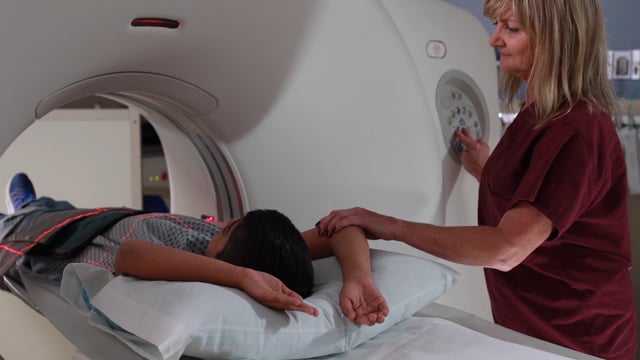Getting a CT (CAT) Scan
What Are CT (CAT) Scans?
A computed tomography scan (CT scan), also called computed axial tomography scan (CAT scan), is a type of imaging test. It uses computers and a rotating X-ray machine to take cross-sectional pictures of the body. CT scans give doctors more detailed images than X-rays can provide. Unlike X-rays, they can show organs, soft tissues, and blood vessels in addition to bones.
How Do We Prepare for a CT Scan?
To help ease any fears, talk to your child about how the test is done and why it's needed. You can describe the room and the equipment that will be used, and reassure your child that you'll be close by. For older kids, explain how keeping still helps the scan get good pictures, be done quickly, and not need to be repeated.
Kids won't feel anything during the scan, but explain that they might hear whirring and buzzing sounds as the machine works. The room may feel cool due to air conditioning used to maintain the equipment.
Your child may be asked to remove all clothing and accessories and change into a hospital gown because buttons, zippers, clasps, or jewelry can affect the images.
For some types of CT scans, kids might get a contrast solution, which helps highlight the area being scanned. If so:
- They might get it through an intravenous line (IV) placed in their hand or arm. Placing the IV will feel like a quick pinprick, but the solution is painless as it goes into the vein.
- They might drink an oral contrast fluid before the scan. Some kids don't like the taste, but it can be flavored to make it more appealing.
Infants and young kids might need sedation if they can’t lie still for the scan, which is common. They’ll get these medicines through an IV line.
Kids who will get sedation or a contrast solution might need to not eat or drink anything for a few hours before the scan to make sure that their stomach is empty.
How Is the Test Done?
A radiographer or radiology technologist does the scan. Your child will lie on their back, side, or stomach on a table, which slowly moves into a large, donut-shaped machine. The machine circles the body, taking many pictures from various angles. These pictures are sent to a computer that records them. It can also put them together to form a three-dimensional (3D) image.
The technician will position your child, then step behind a wall or into another room to operate the machine, viewing your child through a window. The technician will speak to your child through an intercom. You might stay in the CT scan room until the test begins, then join the technician in the outer room. Or you might go to a waiting room. If you stay with the technician, you'll wear a lead apron to protect certain parts of your body.
When the procedure begins, the table moves through the CT machine. Older kids will be asked to hold their breath and stay still for a few seconds at a time to prevent blurred images.
Depending on the type of CT scan, the test can take from several minutes to 45 minutes. A child’s actual exposure time to radiation is much less.
After the scan, your child will wait a few minutes as the technician reviews the images. If they're blurred, parts of the CT scan may need to be redone. If your child got sedation, it will take a little while for the medicine to wear off.
Are There Any Risks From CT Scans?
CT scans are painless. A CT scan involves more exposure to radiation than a regular X-ray does, but the risk is small. Radiologists use the minimum amount of radiation needed to get the best results.
If your daughter is pregnant, tell the technician or doctor before the scan to see if another test would be better. There's a small chance that the radiation could harm the developing baby. But if the CT scan is necessary, precautions can protect the baby.
Contrast solutions are generally safe, with a low risk of allergic reactions. They may contain iodine, which might cause problems for kids with an iodine allergy and some other illnesses. Tell your doctor if your child has a medicine, dye, or food allergy. A patient who’s at risk for an allergic reaction to the contrast solution may need medicines like antihistamines or steroids to help prevent a serious reaction.
If your child got sedation, there's a slight chance that the medicines could slow breathing. If there are any problems with the sedation, the CT scan staff is prepared to treat them right away.
When Are Test Results Ready?
The images are checked by a radiologist (a doctor who's trained in reading and interpreting X-ray and CT scan images). They’ll send the results to your doctor, who will go over the results with you.
Results are usually ready in 1–2 days. In an emergency, the results of a CT scan can be available quickly. In most cases, results can't be given to the patient or family at the time of the test.



